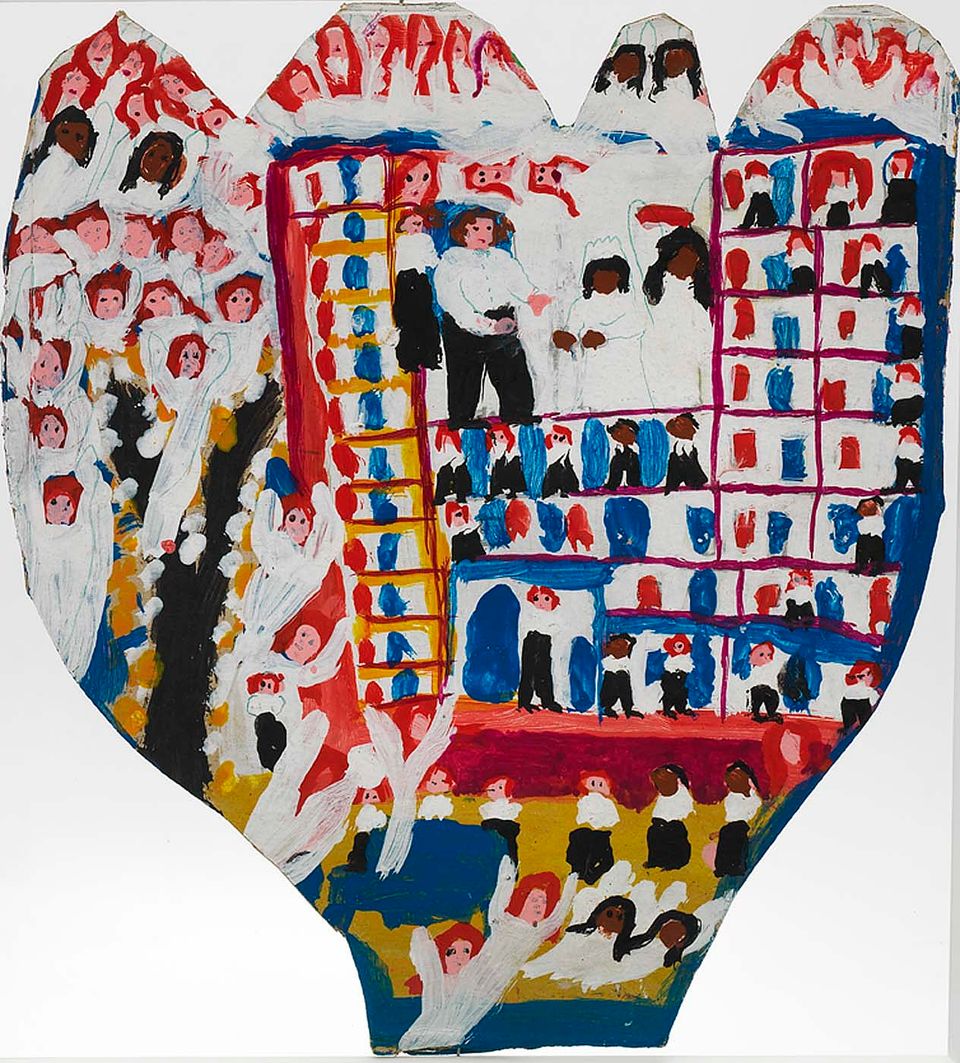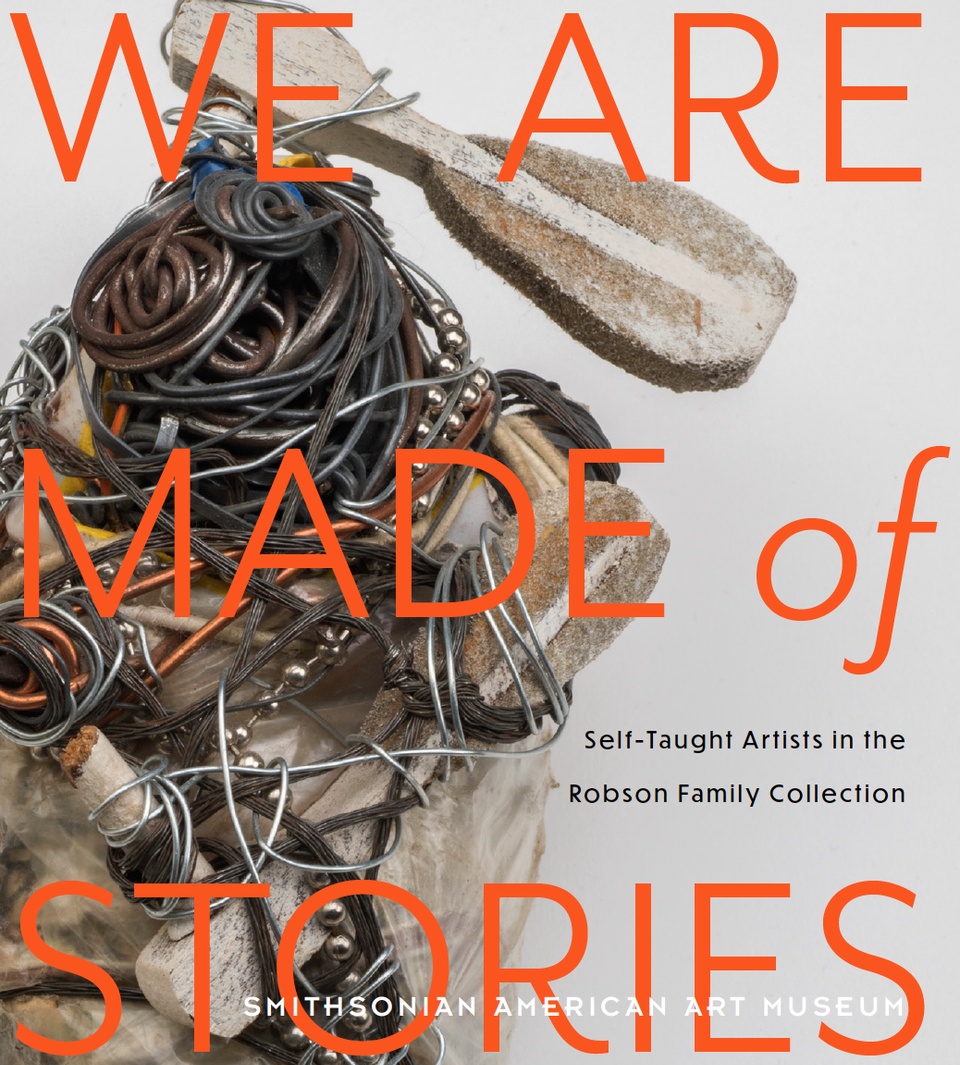William Edmondson
- Biography
William Edmondson, son of Tennessee slaves, did not consider himself an artist when he began carving around 1932, after retiring from his job as a laborer. Inspired by a vision, he emphasized his divine calling, claiming, "Jesus has planted the seed of carving in me" and describing his works as "mirkels." Edmondson carved gravestones, free-standing figurative sculpture, and garden ornaments, using discarded blocks of limestone and chisels fashioned from railroad spikes. Animals, biblical subjects, and secular figures like Eleanor Roosevelt and Nashville school teachers dominated his repertoire.
In several sculptures entitled Crucifixion, Edmondson celebrated Christ as the Savior, the most popular figure in the spiritual tradition of African-American art. The museum's example [SAAM, 1981.141] is an early version, once also called Baby Jesus. Its rectangular silhouette and upright frontality suggest the gravestone tablets that Edmondson saw in his original vision. Crucifixion retains a strong sense of the block's shape and texture in its minimally articulated form and detail. Only the emphatic curves of the lower torso reveal Edmondson's attempt to break away from the block, suggesting that he executed Crucifixion soon after he turned from carving gravestones to more imaginative, free-standing subjects. Compact and stylized, the sculpture conveys its spiritual message with the authority and immediacy of an archaic monument.
Edmondson's work coincided with the revival of direct carving in stone during the 1930s. Unaware of this development, he relied on divine calling and instruction, affirming his ties with other African Americans whose spirituality has provided the impetus for their art, music, and literature.
Lynda Roscoe Hartigan African-American Art: 19th and 20th-Century Selections (brochure. Washington, D.C.: National Museum of American Art)
- Artist Biography
"I is just doing the Lord's work. I didn't know I was no artist till them folks come tole me I was. Every piece of work I got carved . . . is a message . . . a sermon, you might say. A preacher don't hardly get up in the pulpit but he don't preach some picture I got carved. You see, I got to do these things for my heavenly daddy whether folks buy them or not. He ain't never said nothing about pay for it." —William Edmondson quoted in Edmond L. Fuller, Visions in Stone: The Sculpture of William Edmondson(Pittsburgh: The University of Pittsburgh Press, 1973), 12, 22.
The limestone carvings of William Edmondson were virtually unknown beyond his neighborhood in Nashville, Tennessee, until 1936. It was then that Louise Dahl-Wolfe, a New York photographer for Harper's Bazaar, saw his works while visiting friends in Nashville. Dahl-Wolfe took numerous photographs of the artist and his works, which she later showed to Alfred Barr, the director of the Museum of Modern Art in New York. Barr was so impressed with Edmondson's sculptures that he arranged an exhibition for the artist during the following year. In late 1937 the Museum of Modern Art mounted ten of Edmondson's sculptures, and he became the first African-American artist to have a solo exhibition there.
Edmondson was born around 1882 to George and Jane Edmondson in Nashville. The exact year of Edmondson's birth is uncertain—a fire had destroyed the family Bible in which it was recorded. During his early adulthood, Edmondson was employed in a variety of menial jobs and as an orderly at Baptist Hospital in Nashville for almost twenty-five years. Having never married, Edmondson shared the family home with his mother and unmarried sister. Following the deaths of his mother and sister and his retirement from the hospital, Edmondson worked at various part-time jobs, grew vegetables for sale, and lived alone for the remaining years of his life.
Around 1934 Edmondson became a religious convert. He said he was called to preach and cut tombstones to God's command. He attended the United Primitive Baptist Church in Nashville, and remained dedicated to his religion during the years following his conversion. Edmondson stated that God first appeared to him in a vision and ordered him to obtain a mallet and chisels.
Around the same time, Edmondson discovered a pile of limestone that had been accidently dumped on his property and considered it a "gift from heaven." According to Edmondson's accounts, his inspiration was always divine. In a Time magazine article of November 1, 1937, Edmondson was quoted as follows:
"This here stone n'all those out there in the yard—came from God. It's the work of Jesus speaking his mind in my mind. I must be one of His 'ciples. These here is mirkels I can do. Can't nobody do these but me. I can't help carving I just does it. … Jesus has planted the seed of carving in me."
Edmondson began as a tombstone carver working in limestone, and he frequently provided tombstones for members of Nashville's African-American community. Later he progressed to carving figures. His sculptures are simple, rotund, emphatic forms ranging from one to three feet in height. The figures are roughly carved and forms are frequently suggested rather than articulated. He worked primarily in limestone, which was the only material he could acquire inexpensively or without cost. The quality of the limestone in Edmondson's figures varies greatly in color and texture—from a porous granular variety to a type almost as smooth as marble. The majority of the stones Edmondson obtained were rectangular blocks formerly used as sills, lintels, steps, and curbs.
Edmondson's career spanned a period of roughly fifteen years. Part of this time he worked under the auspices of the Works Progress Administration (W.P.A.), a government-sponsored artists' relief program. Unlike most W.P.A.-employed artists who were required to furnish some tangible evidence of their work, Edmondson was apparently not bound by any stipulations. He was free to create works of his choice, and his yard was cluttered with old stones and the images he created from them. These included tombstones, birds, doves, a delightful menagerie of animals comprising rabbits, squirrels, opossums, horses, tortoises, owls, lions, rams, and various other "critters" and reptiles. Edmondson's human figures included preachers, angels, choir girls, brides, nurses, teachers, boxers, comic-strip characters, and "courting gals on the carpet for husbands."
Most of Edmondson's sculptures are symbolic and were inspired by biblical passages. The frequent misspellings and omissions on his crudely lettered tombstones make evident the fact that Edmondson was barely literate. Edmondson's figure style is extremely simple—human faces are frequently curved forms with a few simple indentations denoting features. Feet are often without toes, arms without wrists, and legs without ankles. Textures are usually articulated in the hair of humans and fur of animals. Anatomical proportions are distorted in a manner that lends a vigorous and expressive effect to the pieces.
By 1947 Edmondson's health had begun to fail. He was stricken with cancer, which left him with scarcely enough energy to lift his tools. During the last few years of his life, he worked primarily with small blocks of limestone, and occasionally chiseled inscriptions on tombstones commissioned by members of his church. The grass in his yard had grown tall around his figures and oddly shaped tombstones, creating a virtual forest of mysticism and symbolic figures.
On February 8, 1951, Edmondson died. He was buried in an unmarked grave in Mount Ararat Cemetery on the outskirts of Nashville. Cemetery records for Mount Ararat were subsequently destroyed by fire, and the exact location of Edmondson's grave is unknown. It is ironic that a man who devoted years to carving tombstones for others does not have one identifying his own grave. With a few tools and a forest of stone ranging from Bedford limestone to common fieldstone, Edmondson lived in harmony with his religious beliefs. His works are indeed "mirkels".
Regenia A. Perry Free within Ourselves: African-American Artists in the Collection of the National Museum of American Art (Washington, D.C.: National Museum of American Art in Association with Pomegranate Art Books, 1992)
Luce Artist BiographyTennessee native William Edmondson held a number of jobs, including janitor, fireman, and hospital orderly, before he experienced a holy vision that inspired him to begin carving. At home, surrounded by pieces of stone, he heard a voice telling him to take his tools and "cut figures." When he looked up, Edmondson later recalled, he saw a tombstone hanging in midair and took this as a sign to carve tombstones for Nashville's black community. His repertoire eventually included birdbaths, flowerpots, and human and animal figures. Edmondson kept his finished pieces in his yard, where they attracted the attention of a literary circle from nearby Vanderbilt University. His association with this group eventually led to an exhibition of Edmondson's work at the Museum of Modern Art, in New York, the first African American artist to be featured in a solo exhibition at the museum. Edmondson carved limestone, delivered directly to his backyard by local wrecking companies, with chisels that he fashioned from railroad spikes. He worked up until a year before his death when the heavy work of stone carving became too difficult.
















